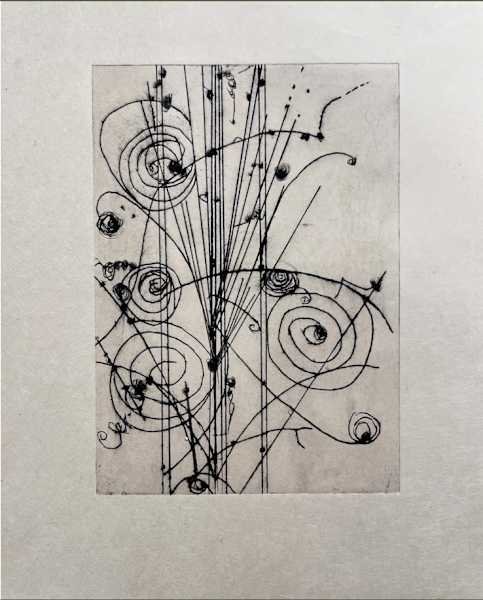Exploring the Cosmic Connection: Elise Wagner and the Omega-Minus First Observation
As an art enthusiast, I am continually inspired by the ways in which artists weave complex concepts into their work. One such artist, is our resident artist at Pier 11 Studio, Elise Wagner, whose exploration of the Omega-minus first observation has captivated my imagination. This baryon, composed of strange quarks, is not merely a scientific curiosity; it serves as a profound metaphor for the mysteries of the universe and the intricate dance of matter and energy.
Omega-minus, First Observation
Bubble chamber picture of the first observed omega-minus particle --discovered in 1964 by a team of physicists from Brookhaven, the University of Rochester and Syracuse University, led by Nicholas Samios of Brookhaven, using the 80-inch bubble chamber at the Alternating Gradient Synchrotron (AGS).
The omega-minus, a baryon composed of three strange quarks, is a classic example of the need for the property called "color" in describing particles.
High Energy Physics explores what the world is made of and how it works at both the smallest and largest scales, seeking new discoveries from the tiniest particles to the outer reaches of space. It is inspired by some of the biggest questions about our universe: What is it made of? What forces govern it? How did it become the way it is today? As with her latest series of paintings titled, Frequencies, from the exhibition Familiar Elements: Visible & Invisible, the thematic elements of Wagner’s work asks these same questions.
Physics illuminated the elegance of this elusive particle and the implications of its existence resonate deeply within her artistic philosophy. Her work reflects the transient nature of life and the beauty found in the ephemeral. This theme is beautifully articulated where the Omega-minus emerges as a recurring motif, symbolizing the interconnectedness of all things.
In her pieces, Wagner employs swirling patterns and dynamic forms that mimic the behavior of particles in motion. This visual language captures the chaos and order inherent in the universe, inviting viewers to engage with the complexities of existence. The deep colors and vibrant earthy tones she chooses evoke familiarity and the vastness of space simultaneously, while the textures suggest the intricate structures of atomic life.
Illusive 1
dry point etching on Kitakata paper 7" x 5"
What I find particularly compelling about Wagner's work is how it serves as a dialogue between science and creativity. Each piece invites contemplation, encouraging us to ponder the unseen forces that shape our reality, much like the Omega-minus itself. As she continues to delve into this theme, Wagner not only fuels her own creativity but also deepens our collective appreciation for the wonders of the universe. In her hands, art transcends mere aesthetics, bridging the gap between the realms of science and imagination in a truly profound way.
—Ren Allen










